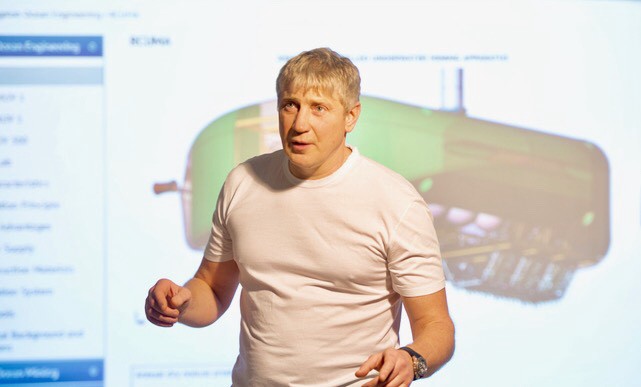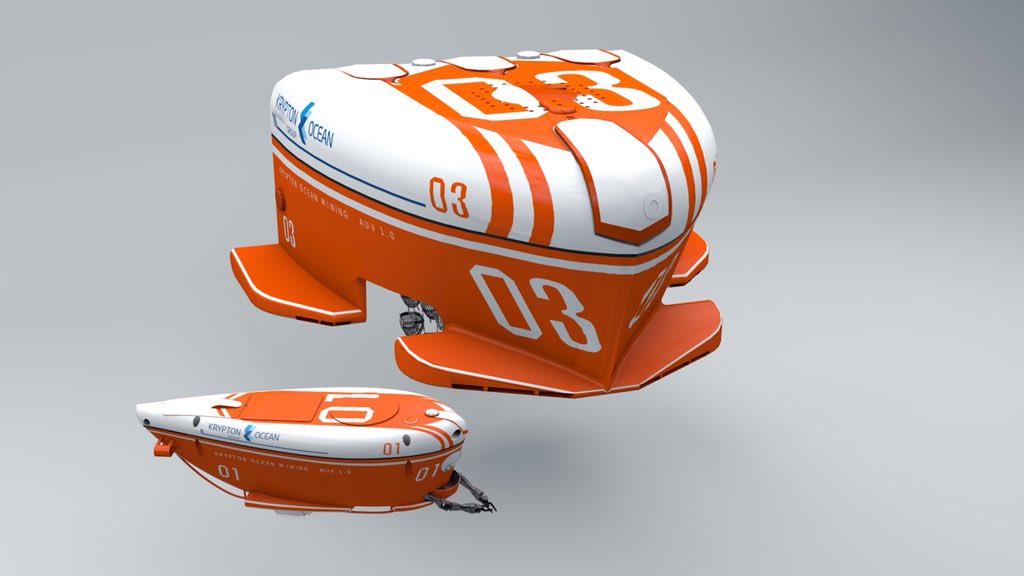One of the fascinating aspects of the deep-sea mining community is how much history is shared among contractors. Nautilus Minerals, GSR, DeepGreen, and, especially, Lockheed, have expertise among their staff stretching all the way back to the early days of the Glomar Explorer. During our investigation into nodules for sale, we interviewed several people who had been working on deep sea mining since the industry’s very inception that are still active in the ongoing progress towards production on the deep seafloor.
Which is why it is noteworthy when new players emerge from other sectors within the mining industry. In the last few years, Krypton Ocean Group has made their presence known through articles, social media, and patent filings. They are a relatively fresh face in the deep-sea mining community, but Krypton Ocean, based in the Ukraine, is not new to the mining world.
“It all started with onshore mining,” says Alina Kryvosheia of Krypton Ocean Group. “Then, we had this idea of mining under water. It became obvious that the depletion of onshore reserves and the urgent need for battery metals for high-tech industries require new green solutions for resource extraction. And we launched Krypton deep-sea mining project.” Led by Vladyslav Kvyatkovskyy, Krypton’s vision includes both extraction and ore processing. Kvyatkovskyy’s career in mining took off with the sale of a titanium-dioxide deposit in the Dnipropetrovsk region of Ukraine. His Demurinskiy Mining and Processing Plant would ultimately become Krypton Ocean Group.
Krypton’s most valuable asset appears to be their patents, issued in the US and Ukraine, which consist of components for an underwater transport module designed to carry polymetallic nodules to the surface from the seafloor and a seafloor collection system. Unlike the current generation of seafloor production tools, including those built by Nautilus Minerals and Japan, as well as the design of GSR’s Patania system, Krypton’s mining tool forgoes the riser and lift system that pumps ore up to a surface ship from the seafloor. Instead, Krypton proposes using elevator system, where the mining tool itself travels between the surface vessel and the mining site, carrying ore and continuously exchanging water throughout the transfer.
“We are starting to assemble the underwater vehicle,” says Kryvosheia, “using which the mining technology will be tested. We have already conducted successful tests of the mining tool, which captures only nodules from the bottom, and the sludge simply flows through its “lattice” structure. Every day we work to improve our solutions, because the ocean environment is extremely sensitive to any interventions.”

Krypton Ocean Group founder Vladislav Kvyatkovskyy discusses the mining process. Photo courtesy Krypton Ocean Group.
Unique among companies working in the deep-sea mining sector, Krypton has invested significant effort into presenting their philosophy, approach, and business model through a series of essays published on their Medium journal, Extractive Industries 2.0. These essays lay out a company vision that draws as much from Arthur C. Clarke as it does from the technical literature and present a view of the direction of deep-sea mining that is both ambitious and naïve. Many of these articles are variations on the common arguments for why we should look towards mining the seafloor, tailored to different audiences. Others range far afield, reflecting a corporate philosophy that is still evolving.
Though these essays are idiosyncratic, to say the least, a few key themes emerge across the series that reveal Krypton’s philosophy on what makes a good mining tool, their novel and unorthodox approach to funding the enterprise through gamification, a focus on blockchain-based distributed ledgers, and an incomplete understanding of the environmental and policy discussions happening among the International Seabed Authority, NGOs, member states, and more established contractors.
Krypton’s proposed mining tool is an autonomous underwater vehicle that travels just above the seabed, collecting polymetallic nodules via a scoop system. According to Krypton, this results in minimal disturbance to the seafloor compared to crawler-style mining tools. Krypton’s vehicles will store nodules on board, and travel to the surface once full. An open basket design means that nodules will be continuously exposed to ambient seawater, preventing the transport of deep seawater to the surface.
It is not clear from these essays, or from other Krypton press releases and media, what the control or support systems for these vehicles might look like.
One thing immediately apparent from Krypton’s media and press releases is that, despite the high-concept vision for deep-sea mining, they have little in the form of material assets. The proposed mining tools and support vessels exist as engineering designs and digital models. The few photographs of hardware testing show small-scale tests of their collection system in a highly controlled test tank, with simulated nodules of fairly uniform size.
Krypton doesn’t just intend to mine the seafloor. Through an elaborate videogame platform, they also envision users mining a cryptocurrency tied to the value of metals from the seafloor. This proposal is so baked in to their business model, that in one piece, published last year, Krypton stated “Sooner or later we will create such a “real-sector” game. We promise. Otherwise, the Extractive Industry 2.0 paradigm we propagate is meaningless.” They state that they are actively pursuing game designers but they would not disclose how much development had been made to date.
The basic gist of the system and how it fits into real-world mining goals works like this: Players sign up for a game that simulates deep-sea mining. While they’re playing, the program uses their excess computing power to mine a Krypton-branded cryptocurrency whose value is somehow tied to the real value of mining prospects. Players can earn that cryptocurrency, which can be used for in-game purchases or converted into real cash at market value.
Independent game designer Sarah Clancy, was skeptical of the viability of such a service. “On paper that sounds amazing,” he said, “Who doesn’t want to get paid to play games, right? The problem is that they’re not approaching this idea like game designers. This is a pitch from an idea man who has no clue how games actually come together, the equivalent of someone talking about an idea for a game that will make millions, unsolicited, as soon as they hear you make games.”
On the game’s premise, Clancy stated that “those players can opt in to be actual investors that will be able to reap some sort of reward from their time or people that just want to play a game about the fast-paced excitement of undersea mining. OK, so why is this interesting? What is the end goal? Is there some undersea elder god that we have to take these materials away from? Why will I want to come back to this game day after day after day?”
The video game scheme highlights another theme running through Krypton’s public statements: an obsession with the blockchain as economic panacea. Though it is not clear exactly how Krypton envisions using a blockchain-based cryptocurrency to drive their deep-sea mining program, they lean heavily on Venezuela’s only partially implemented and now seemingly-abandoned Petro cryptocurrency as precedent for their proposal.
More concerning, however, is what appears to be a general lack of understanding about the broader deep-sea mining community and how the regulatory environment surrounding resource extraction in the high seas functions. In one comment about the current scope of the industry, they state that “rumors suggest, for example, that even Lockheed Martin is also engaged in the development of seabed mining technologies.” Lockheed, through its subsidiary UK Seabed Resources, as well as in past, pre-UNCLOS endeavors, has been very publicly engaged in technology development and seafloor exploration since the industry’s inception. [Krypton Ocean Group reached out to indicate that the quoted statement was intended to be ironic rather than literal. DSMO regrets the errors].
Their understanding of the potential environmental impacts is similarly naïve, with statements that their, still largely untested, approach has “no pollution, no destruction, no effect for the ocean biodiversity.” Even the most optimistic assessments of seafloor mining predict significant changes to the immediate impact site, especially since polymetallic nodules are habitat for numerous species.
Krypton did acknowledge the recent reports on ocean biodiversity. In particular, they released the following statement: “Thanks to many-year collaborative efforts of the International Seabed Authority and numerous marine scientists we are fortunate to grasp the major fears dedicated to possible negative aftermaths of seabed mining with regard to marine biodiversity. Even though the research of numerous deepwater benthic creatures are far from being complete, we greatly appreciate the knowledge-abundant and consistent scientific reports represented during the Pew Side Event in Kingston (Jamaica) in February 2019 by professor Craig R. Smith, Dr. Erik Simon-Lledo, and Dr. Diva Amon.” No representative from Krypton Ocean Group was present at that event.
Throughout their public statements, Krypton frequently presents polymetallic nodule extraction as a renewable resource that continually grows on the seafloor. Though it is broadly true that nodules accrete slowly over time from metals suspended in the water column, they do not do so over human times scales and to argue that nodule mining is sustainable because of their growth rate is a highly tenuous position. Their frequent statement that nodule fields can recover within a century to a millennium is not support by the best-available data.
On the path forward for Krypton, Kryvosheia states that “we are conducting negotiations with a number of states on their sponsorship to us for the International Seabed Authority. Our immediate plan is to apply for an area in the international zone (Clarion Clipperton, Peruvian field, Indian Ocean). For the construction of a processing plant, we are considering sites in proximity to the mining field, such as the coast of Ecuador. Such production is extremely beneficial for the state as a source of valuable metals and a supplier of agricultural products, because the production is waste-free. All residues are used to manufacture mineral fertilizers.” The Deep-Sea Mining Observer, however, could not locate any technical reports demonstrating that ore processing could be waste-free.
Secretary-General Michael Lodge of the International Seabed Authority confirmed that Krypton has, so far, not reached out to the ISA and he is unaware of any collaborations occurring between Krypton and member states, though he did emphasize that they are located in the historic heart of the Soviet and post-Soviet deep-sea industry, so they are well situated to access significant technical expertise.
With little of substance behind their proposals save a few patents and preliminary hardware test, no contracts in the Area or territorial waters, and no presence at the International Seabed Authority, it is hard to tell what of Krypton’s vision is simply designed to attract investors and what represents the realizable goals of the company. High ambition and a trend towards science fiction are not unique within the deep-sea mining community and a similar vision has driven the current progress towards making the enterprise a commercial reality. But vision alone does not bring a multi-national industry operating in the high sea into being, and Krypton Ocean Group still has a long way to go before its assets and infrastructure match its ambition.
